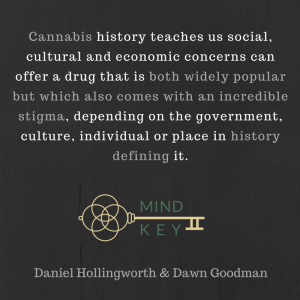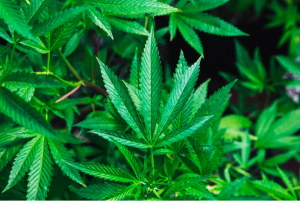
America’s soil: A brief history of cannabis production in the US
By Daniel Hollingworth, with Dawn Goodman
To understand the complex relationship between Americans and cannabis, it is important to investigate and survey traditional American cannabis products and history. Not just in the U.S., but all over the world, the use and cultivation of the hemp plant, or Cannabis, commonly known as marijuana, is evidenced throughout the ages. Some sources date back 25-30,000 years. To trace the entire history of the plant would be a Herculean task. However, we hope to offer some insight into this plant’s role throughout humankind.
What is cannabis?
Cannabis is believed to be native to Asia, and is one of humankind’s oldest agricultural crops. It has been found in doctors’ and herbalists’ medicine cabinets for thousands of years. According to “The Health Effects of Cannabis and Cannabinoids,” published by National Academies Press in 2017, written records of cannabis use by man go as far back as 2600 B.C. in China. Other evidence suggests hemp has been around since 8,000 B.C. Historical accounts suggest clothing was made from its production in what is now Iran and Iraq.
The slang term marijuana came about in the early 1900s, and in fact, the plant has a complicated lingual history. The term marijuana is borrowed from the Mexican Spanish word marihuana and was used to demonize and politicize the “drug” as part of a backlash, in part caused by the propaganda film “Reefer Madness,” and an anti-marijuana campaign by Harry Anslinger, the first commissioner of the Federal Bureau of Narcotics. Marijuana was outlawed for recreational use in the U.S. shortly after and today is still classified as a Schedule I substance by the DEA, along with ecstacy and heroin. This has significantly hampered research on the use of medical marijuana.
According to evidence outlined in “Cannabis: Evolution and Ethnobotany” by Robert Clarke and Mark Merlin, hemp, the fibrous part of the cannabis plant, had prevalent uses in civilizations throughout South Asia, Egypt, Japan, the Mediterranean, as well as ancient Europe. This places the plant among humanity’s oldest cultivated crops. Since then cannabis and all its constituents have continued to play a role in humanity’s development. This role, however, is rapidly evolving as current science and societal image and understanding shift in our rapidly evolving culture.
The complexity of cannabis’ history—then and now
For thousands of years, marijuana held commercial, medicinal and spiritual value, according to Clarke and Merlin. However, its modern history is peculiar, since its medical use has been deeply influenced by economic, social and ethical issues. These issues are now being reconsidered because of recent scientific evidence about the efficacy and safety of medical marijuana. The drug, Epidiolex from GW Pharmaceuticals, is an example of a cannabis-based drug made from a purified ingredient in cannabis called “cannabidiol,” or CBD.
On June 25, 2018, the Food and Drug Administration officially announced its support for Epidiolex making it the first ever government approval of a CBD medication made from cannabis.
Despite its prolific use throughout the ages, recent history has viewed cannabis as an abusive drug. Current research and events show the plant’s rapidly changing role in modern medicine; yet cannabis remains illegal on the federal level. Understanding its history in America can be helpful for understanding this misunderstood plant’s current course.
Investigating and surveying traditional American cannabis production and use
Peter Stafford’s “Psychedelics Encyclopedia” chronicles the American experience with cannabis as of 1606 when the British took it to Canada to be cultivated for maritime purposes. In 1611 they brought it to Virginia and in 1632, the Pilgrims cultivated hemp in New England. This product was also important for maritime use. During the 150 years that preceded the American Revolution, Stafford writes that cannabis production for textiles throughout New England was subsidized by the British government. By 1762, Virginia farmers were penalized if they didn’t grow it. It has been estimated that half the clothing at the time of the American Revolution was made of hemp.
According to the website and records of Mount Vernon, the estate and home of George Washington cultivated cannabis. However, the Mount Vernon organization shows no hard evidence indicating that Washington or any of his contemporaries used cannabis recreationally. Instead, its uses were predominately for the creation of hemp-related products used in the running of the estate itself.
Cannabis’ medicinal history in the United States
Not until the 1840s did marijuana become mainstream medicine in the United States. “Psychedelics Encyclopedia” states that it emerged as a western medicine after a French doctor by the name of Jacques Joseph Moreau found that it suppressed headaches, increased appetites and aided people to sleep. By 1850, marijuana had made its way into the United States Pharmacopeia. The Pharmacopeia being an official public standards-setting authority for all prescription and over-the-counter medicines. It listed marijuana as a possible treatment for numerous afflictions including alcoholism, opiate addiction and insanity.

The fallout of cannabis’ use as a recreational drug
Stafford writes that recreational use of hemp among Americans first showed up in about 1910. This occurred when Mexican laborers in New Orleans and other border towns were introduced to marijuana cigarettes. In fact, the common name “marijuana” was adapted from the Mexican name, “marihuana.”
Despite its medical uses, many Americans’ attitudes towards cannabis shifted at the turn of the century. This was at least partly motivated by Mexican immigration to the U.S. around the time of the 1910 Mexican Revolution, according to Eric Schlosser, author of Reefer Madness: Sex, Drugs, and Cheap Labor in the American Black Market.
“The prejudices and fears that greeted these peasant immigrants also extended to their traditional means of intoxication: smoking marijuana,” Schlosser wrote for The Atlantic in 1994. “Police officers in Texas claimed that marijuana incited violent crimes, aroused a ‘lust for blood,’ and gave its users ‘superhuman strength.’” He further wrote,“Rumors spread that Mexicans were distributing this ‘killer weed’ to unsuspecting American schoolchildren.”
Massachusetts was the first state to make recreational marijuana illegal in 1911. In August 1937, President Franklin Roosevelt signed the Marijuana Tax Act. This act came just a year after “Reefer Madness “warned parents that drug dealers would invite their teenagers to jazz parties and get them hooked on “reefer.” In addition to imposing the tax requirement, the law also declared cannabis a narcotic. New penalties for its use and distribution were five to 20 years for a first offense; ten to 40 for a second.
Following this act in 1941, the drug was dropped from the American Pharmacopeia after about a century of widespread use, as per the American Medical Association (AMA) policy. According to its resolution 907, the AMA has since reversed its stance on medical marijuana use.
The social acceptance of cannabis
Moves toward social acceptance of cannabis began in 1961 when Americans began to generally show interest in its mental effects. The 1960s fascination with LSD and “magic mushrooms” changed the image of cannabis. Many people started to regard it as a similar, but milder substance than these psychotropics. Stafford said that folk and rock musicians greatly encouraged this new image. He suggested they made oblique and enticing references to marijuana in their lyrics.
Cannabis, although still illegal, moved a long way toward acceptance socially and morally. In fact, it attained a status similar to that of whiskey during Prohibition.

Cannabis in its native plant form.
The shift in government policy
From 1970-1989 cannabis had a rollercoaster of a time dealing with the government policies. In 1970 the Controlled Substances Act classified marijuana as a drug with “No Accepted Medical Use” and as a result was placed as a Schedule I drug. According to the DEA’s Controlled Substances Act Schedule I drugs include all drugs which are considered to have a high potential for abuse, have no accepted medical use, and are generally not recognized as safe.
In a televised news conference on May 1, 1971, President Nixon declined the Shafer Commission’s recommendation to legalize marijuana According to Public Papers of the Presidents of the United States, a month later Nixon declared a war on drugs. As a result, in 1973 the Drug Enforcement Agency (DEA) was established.
In February 1978, The New York Times reported that New Mexico passed the first state law recognizing the medical value of marijuana. Later, in May 1985, Marinol, a drug containing THC (the main component of marijuana), was approved by the FDA to treat nausea and vomiting associated with cancer chemotherapy. Because of this, on September 6, 1988, in Docket 86-22, DEA Judge Francis Young recommended marijuana be placed as a Schedule II drug, which has essentially the same definition as a Schedule I drug, but with an accepted medical usage, according to the DEA’s Controlled Substances Act. However a few months later, on December 30, 1989, a history of the DEA records that administrator, Jack Lawn, overruled Young, and ordered that cannabis remain a Schedule I controlled substance, maintaining the DEA’s stance that cannabis had no medicinal value.
The legalization of medical marijuana
With Proposition 215, California became the first state to legalize medical marijuana on November 5, 1996. To date, there are 29 states in total that have done the same.
Today, there is still much lingering uncertainty surrounding cannabis. Federally, it remains a Schedule I drug. US News writes that on Jan. 4, 2018, US Attorney General Jeff Sessions rescinded the policy by President Obama’s Justice Department. This policy would have barred federal law enforcement officials from interfering in states where the drug is legal.
Cannabis history teaches us social, cultural and economic concerns can offer a drug that is widely popular. However, there is also an incredible stigma associated with this drug as well. Both of these viewpoints depend heavily on the government, culture, individual or place in history defining it. Now that the large database of scientific evidence regarding the pharmacological potential of cannabis is in agreement. With the interests of the market, cannabis’ place is becoming redefined on a government and economic level. The lesson from the past is that it is now pivotal to manage the cannabis affair fairly. We need to do this in as unbiased a manner as possible, emphasizing the health benefits for patients.
For further reading:
Hemp—An American History Revisited, Vital Resource to Conscientious Weed (2003)



 Understanding our relationship and history with cannabis is essential to overcoming our bias in regard to its newer uses.
Understanding our relationship and history with cannabis is essential to overcoming our bias in regard to its newer uses.  Understanding our relationship and history with cannabis is essential to overcoming our bias in regard to its newer uses.
Understanding our relationship and history with cannabis is essential to overcoming our bias in regard to its newer uses.